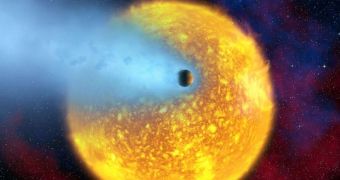One of the things plaguing the field of exoplanetary research today is the fact that data collected about planets orbiting other stars are not very clear-cut. That is to say, of the hundreds of bodies thus far discovered, only a handful have been observed directly, and had their properties measured accurately. Generally, looking at an exoplanet is something incredibly difficult to do, and it requires complex mathematics and extrapolations in order to become possible. But now experts are working on a new detection method, which they hope will advance this field to new heights, ScienceNow reports.
The main idea behind the newly-proposed technique is relatively simple. A very high-resolution spectrograph is pointed at a planet's moon, and the light that bounces off the natural satellite is then analyzed. In this manner, by looking at the Moon, researchers were able to infer from observations data alone that Earth's atmosphere contains oxygen, nitrogen and sodium. Experts are convinced that a more evolved form of the approach could be used successfully for deep-space studies, in discovering planets that are very far away.
The method is derived from a phenomenon known as stellar occultation, which appears when an exoplanet moves in front of its parent star, and comes between the celestial fireball and Earth. As this happens, the atmosphere around the exoplanet subtracts some wavelengths from the light of the host star, and adds others, depending on its chemical composition. Since 2001, it was proven that it's possible to detect chemicals in alien atmosphere using this method, but thus far it remained unclear whether the approach could be used for Earth-sized exoplanets as well.
The idea was tested in 2008, during an eclipse. Astrophysicists looked at how filtered sunlight looked like after passing through Earth's atmosphere. Our planet was located between the Sun and the Moon, and so the light bounced off our natural satellite. High-sensitivity spectrographs were trained on the reflection, and researchers were able to find chemical compounds such as ozone, oxygen, nitrogen, and sodium. The 1.93-meter telescope at the French Observatoire de Haute Provence was used for the job. The SOPHIE high-resolution spectrograph was the main tool used to conduct the study.
“The surprise was that we succeeded with extremely sparse observations under relatively bad weather conditions. But seeing how easily oxygen was seen strongly argues in favor of high-spectral-resolution searches [of Earth-like extrasolar planets],” explains astrophysicist Alfred Vidal-Madjar, who is based at the Institut d'Astrophysique de Paris.
Details of the team's work will appear in an upcoming issue of the esteemed scientific journal Astronomy & Astrophysics.”This is an important paper. Many of us have great hopes for the use of this method to make the first honest search for life outside the solar system,” concludes astronomer David Charbonneau, from the Cambridge, Massachusetts-based Harvard-Smithsonian Center for Astrophysics (CfA).

 14 DAY TRIAL //
14 DAY TRIAL //